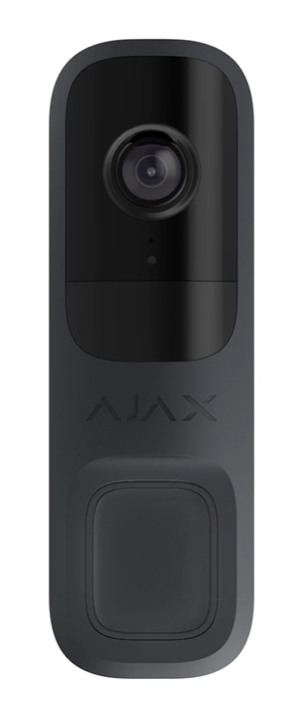
Released earlier this year, the DoorBell is the latest peripheral for the Ajax ecosystem, featuring a 4 MP CMOS camera sensor with HDR technology and IR illumination at a distance up to 6 metres, built-in AI, IR sensor, and app control. As soon as a visitor rings the doorbell, the user receives a notification, sees who’s at the door, and can start a two-way conversation via the Ajax app. The DoorBell also functions as a security camera: it can be set to send smartphone notifications about the movement of people, animals, or vehicles, and records video on the Ajax NVR or Ajax Cloud Storage.
The bell was supplied as a standalone product without an external chime unit, so for the purpose of this review we will simply be operating the device using the Ajax app and assessing its capabilities on that level rather than as part of a whole home security set-up which includes an NVR or hub.
Getting started
After unboxing the unit, the user manual is accessed by scanning a QR on the quick start guide sheet. This page provides all of the information required to set up the device, which is extremely simple and typical of modern technology utilising Wi-Fi connectivity. This is particularly useful as the text on the quick start guide is rather small.
The unit is designed to be installed at a height of 1.2-1.5m above the floor and should be fitted to a flat surface. The bell comes supplied with two wedges (10° down/up or 25° right/left) to ensure the camera is best positioned to capture images.
The bell has terminals for connecting a 12-24V or 16-24V 50/60 Hz power supply and also boasts a backup battery in case of power loss. Once connected it is time to add the unit to the system via the Ajax app. Existing customers familiar with the app can just add the device to their NVR set-up while new users will need to register on the app first and then add the device. This is achieved by scanning the QR on the box which instantly recognises the product and allows users to select a space and name the bell. The prompt will then ask for the password for the Wi-Fi and once entered the unit is live.
Settings
There are multiple options for personalising the functions of the DoorBell which will depend on whether it is being used as a standalone device or form part of an Ajax ecosystem. If it is part of a larger system already installed, the unit can be set up not only as a doorbell responding to button activation, but as another connected camera and triggered using the same parameters as existing devices and included in the Video Wall display. For this report we are testing the unit’s capabilities as a video doorbell only, running alone on the app separate from any other technology.
The settings for the device are configured using the app. These include night mode, selecting the required AI object detection and whether activations should be confirmed using PIR.
Read the full review in the July 2025 edition of PSi magazine

